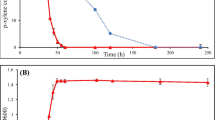Abstract.
Sphingomonas strain ASU1 was isolated from an industrial wastewater bioreactor and grew on 2,6-dimethylnaphthalene (2,6-DMN) as the sole carbon/energy source. The genes for a xylene monooxygenase were cloned from strain ASU1. Expression of the ASU1 xylene monooxygenase was compared to expression of the pWWO xylene monooxygenase in Escherichia coli. Both monooxygenases transformed p-xylene and 2,6-DMN by initially hydroxylating one methyl group. In addition, the ASU1 monooxygenase also hydroxylated the second methyl group on p-xylene and 2,6-DMN whereas the pWWO monooxygenase hydroxylated the second methyl group only on p-xylene. Endogenous E. coli enzymes contributed to further oxidation of the resulting aromatic alcohols to form aromatic carboxylates.
Similar content being viewed by others
Author information
Authors and Affiliations
Corresponding author
Rights and permissions
About this article
Cite this article
Bramucci, M., Singh, M. & Nagarajan, V. Biotransformation of p-xylene and 2,6-dimethylnaphthalene by xylene monooxygenase cloned from a Sphingomonas isolate. Appl Microbiol Biotechnol 59, 679–684 (2002). https://doi.org/10.1007/s00253-002-1068-7
Received:
Revised:
Accepted:
Published:
Issue Date:
DOI: https://doi.org/10.1007/s00253-002-1068-7




